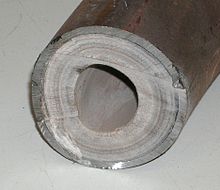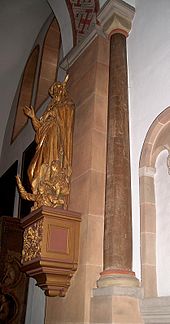
Back رواسب كلسية Arabic Tosca (sediment) Catalan Vodní kámen Czech Кăм CV Kedelsten Danish Kesselstein German Toba (sedimento) Spanish Katlakivi ET Kattilakivi Finnish Tartre (eau) French

Limescale is a hard, chalky deposit, consisting mainly of calcium carbonate (CaCO3). It often builds up inside kettles, boilers, and pipework, especially that for hot water. It is also often found as a similar deposit on the inner surfaces of old pipes and other surfaces where hard water has flowed. Limescale also forms as travertine or tufa in hard water springs.
The colour varies from off-white through a range of greys and pink or reddish browns, depending on the other minerals present. Iron compounds give the reddish-browns.
In addition to being unsightly and hard to clean, limescale can seriously damage or impair the operation of various plumbing and heating components.[1] Descaling agents are commonly used to remove limescale. Prevention of fouling by scale build-up relies on the technologies of water softening or other water treatment.

- ^ Hermann Weingärtner, "Water" in Ullmann's Encyclopedia of Industrial Chemistry, December 2006, Wiley–VCH, Weinheim. doi:10.1002/14356007.a28_001